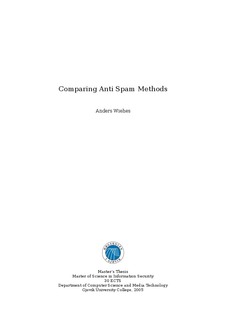| dc.contributor.author | Wiehes, Anders | |
| dc.date.accessioned | 2008-04-01T12:11:23Z | |
| dc.date.issued | 2005 | |
| dc.identifier.uri | http://hdl.handle.net/11250/143763 | |
| dc.description.abstract | NORSK:
Mange Internett-brukere bruker epost til å kommunisere. De er avhengige av at epostene
de sender når mottakeren. Spam har gjort at epostsystemet har blitt mer upålitelig på
grunn av at epost kan feilaktig bli stoppet i spam-filtere eller at de kan drukne i spam i
mottakers innboks.
Internett-samfunnet bør ha som mål å jobbe mot et Internett med mindre spam. Dette
kan gjøres via lover og rettssystemet, tekniske løsninger og brukeropplysning. Denne
masteravhandlingen ser på og sammenligner forskjellige tekniske løsninger for å detektere
spam når den blir sendt til mottakers Internett-tilbyder eller når den har havnet i
mottakers innboks.
Det har blitt utført et eksperiment for å utvikle ny viten om hvordan forskjellige
antispammetoder gjør det i forhold til hverandre på et produksjonssystem som behandler
over 300,000 eposter på en måned. I denne rapporten blir resultatene av eksperimentet
presentert og forslag til antispamlÃÿsninger blir også diskutert. | no |
| dc.description.abstract | ENGELSK:
Most Internet users use mail to communicate electronically. They depend on the mail
system to deliver their mails to the recipient. Spam has made the mail system more
unreliable because mail can get falsely caught by spam filters on the way to the recipient
or mail can drown among spam in the recipients inbox.
The goal of the Internet community should be to work toward a more usable Internet
with less spam. Possible ways to do this are through the law and the legal system, technical
solutions and user awareness. This thesis looks at and compares different technical
methods used to detect spam when it is sent to the receiving Internet service provider or
when it has entered the receiving user’s inbox.
An experiment has been conducted to gain new knowledge about how the anti spam
methods compares with each other on a real system handling over 300,000 emails in a
month. The results of the experiment are presented and solutions for anti spam systems
is also discussed in this thesis. | en |
| dc.format.extent | 377551 bytes | |
| dc.format.mimetype | application/pdf | |
| dc.language.iso | eng | en |
| dc.subject | datamaskinnett | en |
| dc.subject | datasikkerhet | en |
| dc.subject | spam | en |
| dc.subject | e-post | en |
| dc.title | Comparing Anti Spam Methods | en |
| dc.type | Master thesis | en |
| dc.subject.nsi | VDP::Mathematics and natural science: 400::Information and communication science: 420::Security and vulnerability: 424 | en |
